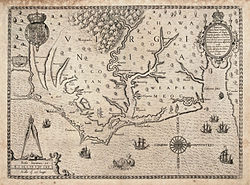Top Qs
Timeline
Chat
Perspective
Coree
Extinct Native American tribe in North Carolina From Wikipedia, the free encyclopedia
Remove ads
The Coree were a very small Native American tribe, who once occupied a coastal area south of the Neuse River[2] in southeastern North Carolina in the area now covered by Carteret and Craven counties. Early 20th-century scholars were unsure of what language they spoke,[3] but the coastal areas were mostly populated by Iroquois and Algonquian peoples.
Remove ads
History
The Coree were not described by English colonists until 1701, by which time their population had already been reduced to as few as 125 members, likely due to epidemics of infectious disease and warfare. In the early 18th century, the Coree and several other tribes were allied with the Iroquoian Tuscarora against the colonists. In 1711, they participated in the Tuscarora War, trying to drive out the English settlers. The Native Americans were unsuccessful and suffered many fatalities.
By 1715, surviving Coree merged with the remaining members of the nearby Algonquian-speaking Machapunga and settled in their single village of Mattamuskeet in present-day Hyde County.[4][3] This was on the shore of Lake Mattamuskeet.[4]
The Coree soon left the Machapunga and joined the Tuscaroras.[1]
Remove ads
Language
The ethnographer James Mooney speculated that the Coree were related to the Iroquoian-speaking Cherokee, but he did not have convincing evidence. According to limited colonial reports, they spoke a language that did not appear to be mutually intelligible with any of the three major language stocks (Carolina Algonquian, Iroquoian Tuscarora, and Woccon, possibly Waccamaw, to John Lawson, who described Coree after recording vocabularies of the other three.[5]
On the other hand, the Coree occupied territory that was historically mostly that of Tuscaroras, which suggests they were affiliated with these peoples, whom they ultimately merged into.
Remove ads
References
Bibliography
Wikiwand - on
Seamless Wikipedia browsing. On steroids.
Remove ads

